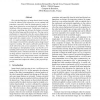Free Online Productivity Tools
i2Speak
i2Symbol
i2OCR
iTex2Img
iWeb2Print
iWeb2Shot
i2Type
iPdf2Split
iPdf2Merge
i2Bopomofo
i2Arabic
i2Style
i2Image
i2PDF
iLatex2Rtf
Sci2ools
ICRA
2002
IEEE
2002
IEEE
Images Interpolation for Image-Based Control under Large Displacement
The principal deficiency of image-based visual servoing is that the induced (3D) trajectories are not optimal and sometimes, especially when the displacement to realize is large, these trajectories are not physically valid leading to the failure of the servoing process. Furthermore, visual control needs a matching step between the features extracted from the initial image and the desired one. This step can be problematic (or impossible) when the camera displacement between the acquisitions of the initial and desired images is large and/or for complex scenes. To resolve these deficiencies, we couple an image interpolation process between N relay images extracted from a database and an image-based trajectory tracking. The camera calibration and the model of the observed scene are not assumed to be known. The relay images are interpolated in such a way that the corresponding camera trajectory is minimal. First a closed form collineation path is obtained and then the analytical form of ...
| Added | 15 Jul 2010 |
| Updated | 15 Jul 2010 |
| Type | Conference |
| Year | 2002 |
| Where | ICRA |
| Authors | Youcef Mezouar, Anthony Remazeilles, Patrick Gros, François Chaumette |
Comments (0)

